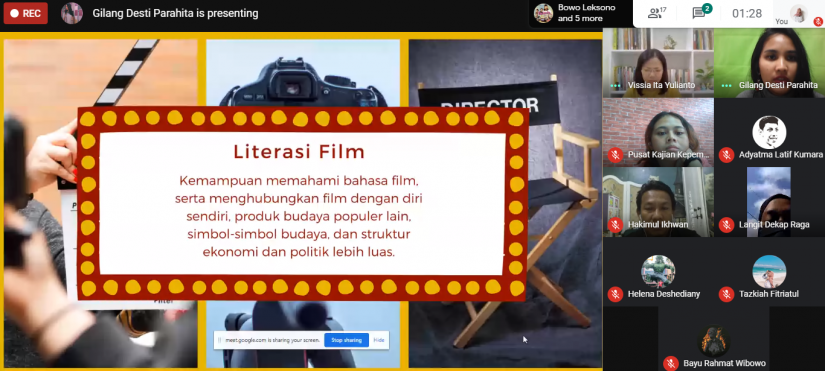
While explaining the importance of having film literacy, Gilang also mentioned at least four elements of the films that should we know. First, there were dramatic and cinematic structures in a film as the efforts of the producer to make the film more alive and more realistic. Second, relation of the film and audience could pictured how the dramatic and teathrical effects of the film could affect the audience. Third, contexts and consequences which were positioned to explain why this film was produced, distributed, showed, also the effects to the society. Creation became the last element of the film literacy which contained about the process of creative powers were distributed into the production of a film.
Meanwhile, Bowo Leksono explained more about the production process of a film that was done by the students or the youths. As the founder of CLC Purbalingga, Bowo who was familiar with the cinematic world explained that the youths in a cinematography extracullicular had a unique characteristic: they often brought love stories into the production process of a film. In this case, Bowo underlined that uniqueness could be overcome by giving suggestions to the youths to add more movie references to make them know more about other stories of the films. Bowo also emphasized and did not forget to say that reading was a main key to produce a good quality visual works. The logic was, the more you read, you would have more knowledges and insights related to the contents of film making and you could also be more creative.
Bowo also gave an example that in the process of a film, either it was a fiction or a documentary ones, it would have many references that could we get from the problems which were close to humans lives. The goal was to make the theme of the films not limited and not monotone. But, political issues, historical issues, and cultural issues could not be separated from both of those themes. It was up to us as the part of the films to produce, visualize it, and organize it to make it enjoyable and did not make the viewers bored. Bowo said that the activities of these youths that incorporated in the film making production was a part of the realization of a character builiding which was going to be useful in the future. By learning the film production, the youths could explore their skills in discussion, exchanging ideas, pictured our current society problems, and increasing their creativities.
Ending this discussion, both of the speakers talked that a film production process was not an easy thing to do. To produce a good quality of visual works, according to what Bowo Leksono said in the beginning, it needed to increase your film references and read more books. Gilang also added that the more we critized and the more we watched good quality films, then our interest in a good quality films would be getting sharpened. Gilang also suggested to learn more about the directors who had important role behind the scenes of the films. The goal was to understand about the pattern of ev
